2008 CHEVROLET AVEO child seat
[x] Cancel search: child seatPage 52 of 384

2. If the child restraint manufacturer recommends that
the top tether be attached, attach and tighten the
top tether to the top tether anchor, if equipped.
Refer to the child restraint instructions and
the following steps:
2.1. Find the top tether anchor.
2.2. Flip the cover to access the top tether
anchors.
2.3. For hatchback models, remove the cargo
shade before installing the top tether.
The cargo shade should remain off while
the top tether is in use.
2.4. Raise the headrest or head restraint if the
desired seating position has an adjustable
headrest or head restraint. SeeHead
Restraints on page 1-6.2.5. Route and tighten the top tether according
to your child restraint instructions and the
following instructions:
If the position you are
using does not have a
headrest or head restraint
and you are using a
single tether, route the
tether over the seatback.
If the position you are
using does not have a
headrest or head restraint
and you are using a
dual tether, route the
tether over the seatback.
1-48
Page 53 of 384
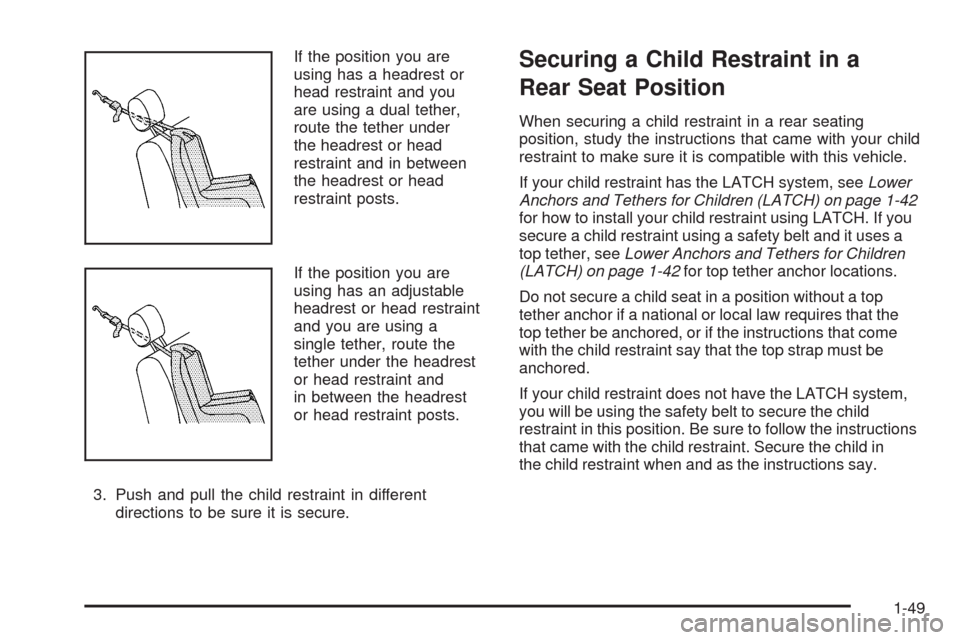
If the position you are
using has a headrest or
head restraint and you
are using a dual tether,
route the tether under
the headrest or head
restraint and in between
the headrest or head
restraint posts.
If the position you are
using has an adjustable
headrest or head restraint
and you are using a
single tether, route the
tether under the headrest
or head restraint and
in between the headrest
or head restraint posts.
3. Push and pull the child restraint in different
directions to be sure it is secure.Securing a Child Restraint in a
Rear Seat Position
When securing a child restraint in a rear seating
position, study the instructions that came with your child
restraint to make sure it is compatible with this vehicle.
If your child restraint has the LATCH system, seeLower
Anchors and Tethers for Children (LATCH) on page 1-42
for how to install your child restraint using LATCH. If you
secure a child restraint using a safety belt and it uses a
top tether, seeLower Anchors and Tethers for Children
(LATCH) on page 1-42for top tether anchor locations.
Do not secure a child seat in a position without a top
tether anchor if a national or local law requires that the
top tether be anchored, or if the instructions that come
with the child restraint say that the top strap must be
anchored.
If your child restraint does not have the LATCH system,
you will be using the safety belt to secure the child
restraint in this position. Be sure to follow the instructions
that came with the child restraint. Secure the child in
the child restraint when and as the instructions say.
1-49
Page 54 of 384
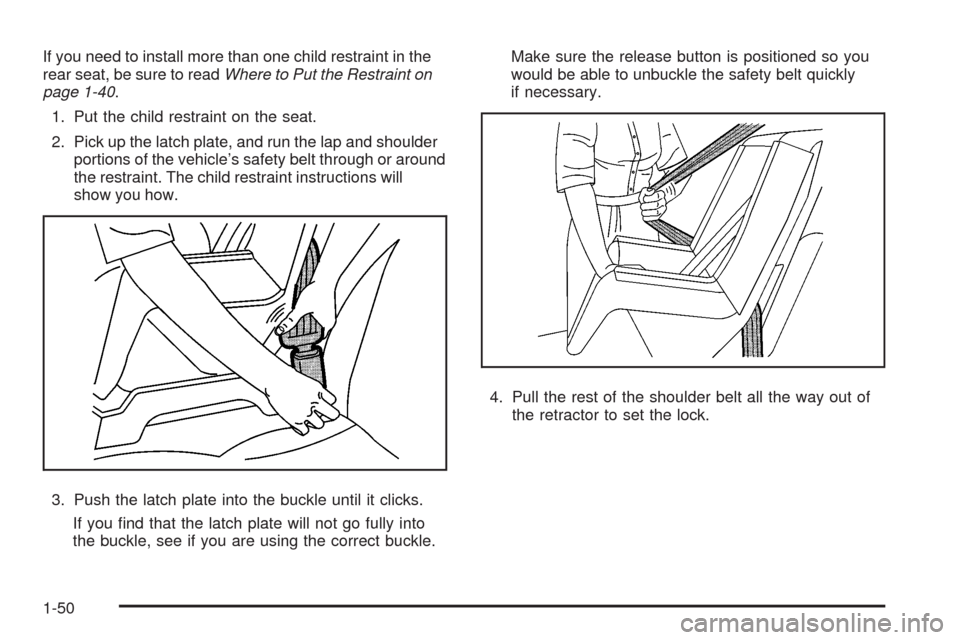
If you need to install more than one child restraint in the
rear seat, be sure to readWhere to Put the Restraint on
page 1-40.
1. Put the child restraint on the seat.
2. Pick up the latch plate, and run the lap and shoulder
portions of the vehicle’s safety belt through or around
the restraint. The child restraint instructions will
show you how.
3. Push the latch plate into the buckle until it clicks.
If you find that the latch plate will not go fully into
the buckle, see if you are using the correct buckle.Make sure the release button is positioned so you
would be able to unbuckle the safety belt quickly
if necessary.
4. Pull the rest of the shoulder belt all the way out of
the retractor to set the lock.
1-50
Page 56 of 384
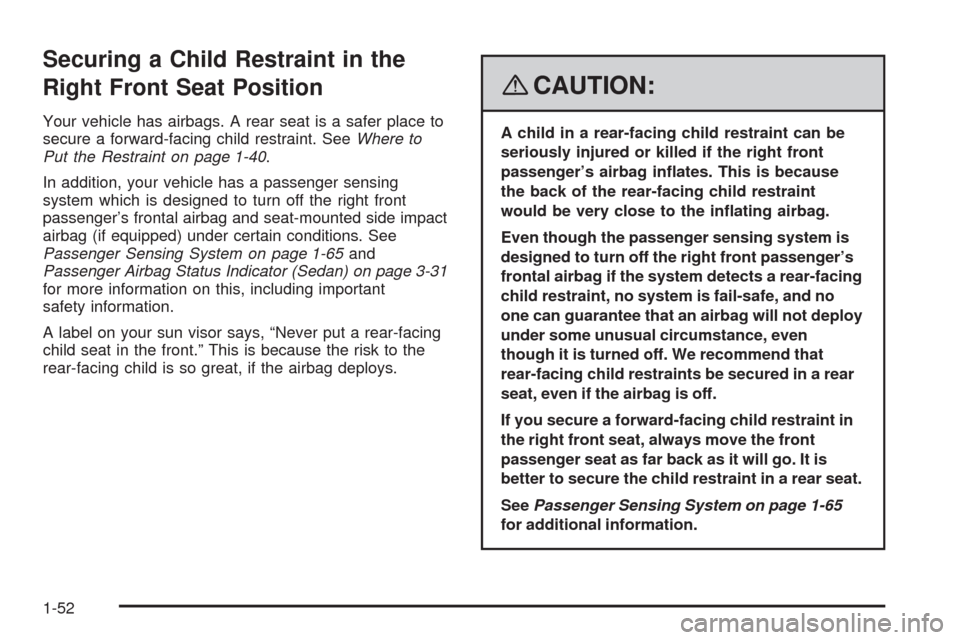
Securing a Child Restraint in the
Right Front Seat Position
Your vehicle has airbags. A rear seat is a safer place to
secure a forward-facing child restraint. SeeWhere to
Put the Restraint on page 1-40.
In addition, your vehicle has a passenger sensing
system which is designed to turn off the right front
passenger’s frontal airbag and seat-mounted side impact
airbag (if equipped) under certain conditions. See
Passenger Sensing System on page 1-65and
Passenger Airbag Status Indicator (Sedan) on page 3-31
for more information on this, including important
safety information.
A label on your sun visor says, “Never put a rear-facing
child seat in the front.” This is because the risk to the
rear-facing child is so great, if the airbag deploys.
{CAUTION:
A child in a rear-facing child restraint can be
seriously injured or killed if the right front
passenger’s airbag in�ates. This is because
the back of the rear-facing child restraint
would be very close to the in�ating airbag.
Even though the passenger sensing system is
designed to turn off the right front passenger’s
frontal airbag if the system detects a rear-facing
child restraint, no system is fail-safe, and no
one can guarantee that an airbag will not deploy
under some unusual circumstance, even
though it is turned off. We recommend that
rear-facing child restraints be secured in a rear
seat, even if the airbag is off.
If you secure a forward-facing child restraint in
the right front seat, always move the front
passenger seat as far back as it will go. It is
better to secure the child restraint in a rear seat.
SeePassenger Sensing System on page 1-65
for additional information.
1-52
Page 57 of 384
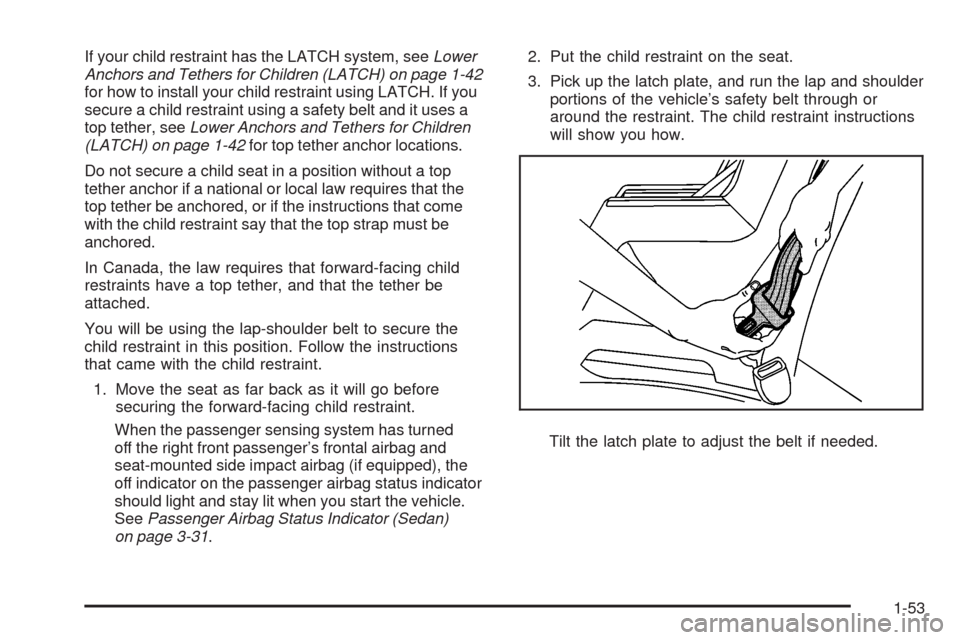
If your child restraint has the LATCH system, seeLower
Anchors and Tethers for Children (LATCH) on page 1-42
for how to install your child restraint using LATCH. If you
secure a child restraint using a safety belt and it uses a
top tether, seeLower Anchors and Tethers for Children
(LATCH) on page 1-42for top tether anchor locations.
Do not secure a child seat in a position without a top
tether anchor if a national or local law requires that the
top tether be anchored, or if the instructions that come
with the child restraint say that the top strap must be
anchored.
In Canada, the law requires that forward-facing child
restraints have a top tether, and that the tether be
attached.
You will be using the lap-shoulder belt to secure the
child restraint in this position. Follow the instructions
that came with the child restraint.
1. Move the seat as far back as it will go before
securing the forward-facing child restraint.
When the passenger sensing system has turned
off the right front passenger’s frontal airbag and
seat-mounted side impact airbag (if equipped), the
off indicator on the passenger airbag status indicator
should light and stay lit when you start the vehicle.
SeePassenger Airbag Status Indicator (Sedan)
on page 3-31.2. Put the child restraint on the seat.
3. Pick up the latch plate, and run the lap and shoulder
portions of the vehicle’s safety belt through or
around the restraint. The child restraint instructions
will show you how.
Tilt the latch plate to adjust the belt if needed.
1-53
Page 59 of 384
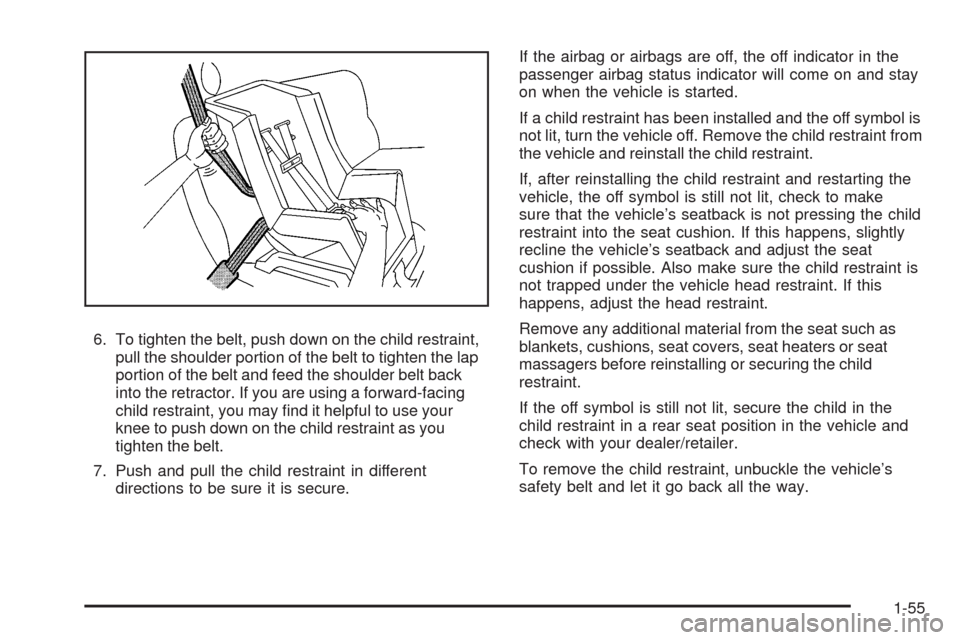
6. To tighten the belt, push down on the child restraint,
pull the shoulder portion of the belt to tighten the lap
portion of the belt and feed the shoulder belt back
into the retractor. If you are using a forward-facing
child restraint, you may find it helpful to use your
knee to push down on the child restraint as you
tighten the belt.
7. Push and pull the child restraint in different
directions to be sure it is secure.If the airbag or airbags are off, the off indicator in the
passenger airbag status indicator will come on and stay
on when the vehicle is started.
If a child restraint has been installed and the off symbol is
not lit, turn the vehicle off. Remove the child restraint from
the vehicle and reinstall the child restraint.
If, after reinstalling the child restraint and restarting the
vehicle, the off symbol is still not lit, check to make
sure that the vehicle’s seatback is not pressing the child
restraint into the seat cushion. If this happens, slightly
recline the vehicle’s seatback and adjust the seat
cushion if possible. Also make sure the child restraint is
not trapped under the vehicle head restraint. If this
happens, adjust the head restraint.
Remove any additional material from the seat such as
blankets, cushions, seat covers, seat heaters or seat
massagers before reinstalling or securing the child
restraint.
If the off symbol is still not lit, secure the child in the
child restraint in a rear seat position in the vehicle and
check with your dealer/retailer.
To remove the child restraint, unbuckle the vehicle’s
safety belt and let it go back all the way.
1-55
Page 70 of 384

If you have a hatchback, the airbag off symbol will be
visible in the Secondary Information Center (SIC) during
the system check. SeeSecondary Information Center
(SIC) (Hatchback Only) on page 3-43. When the system
check is complete, the airbag off symbol will be visible
under certain conditions.
The passenger sensing system will turn off the right
front passenger’s frontal airbag and seat-mounted side
impact airbag (if equipped) under certain conditions.
The driver’s airbags are not part of the passenger
sensing system.The passenger sensing system works with a sensor that
is part of the right front passenger’s seat. The sensor
is designed to detect the presence of a properly-seated
occupant and determine if the right front passenger’s
frontal airbag and seat-mounted side impact airbag
(if equipped) should be enabled (may inflate) or not.
Accident statistics show that children are safer if
they are restrained in the rear rather than the front seat.
We recommend that children be secured in a rear
seat, including: an infant or a child riding in a rear-facing
child restraint; a child riding in a forward-facing child
seat; an older child riding in a booster seat; and children,
who are large enough, using safety belts.
A label on your sun visor says, “Never put a rear-facing
child seat in the front.” This is because the risk to the
rear-facing child is so great, if the airbag deploys. United States –
Hatchback
Canada – Hatchback
1-66
Page 71 of 384
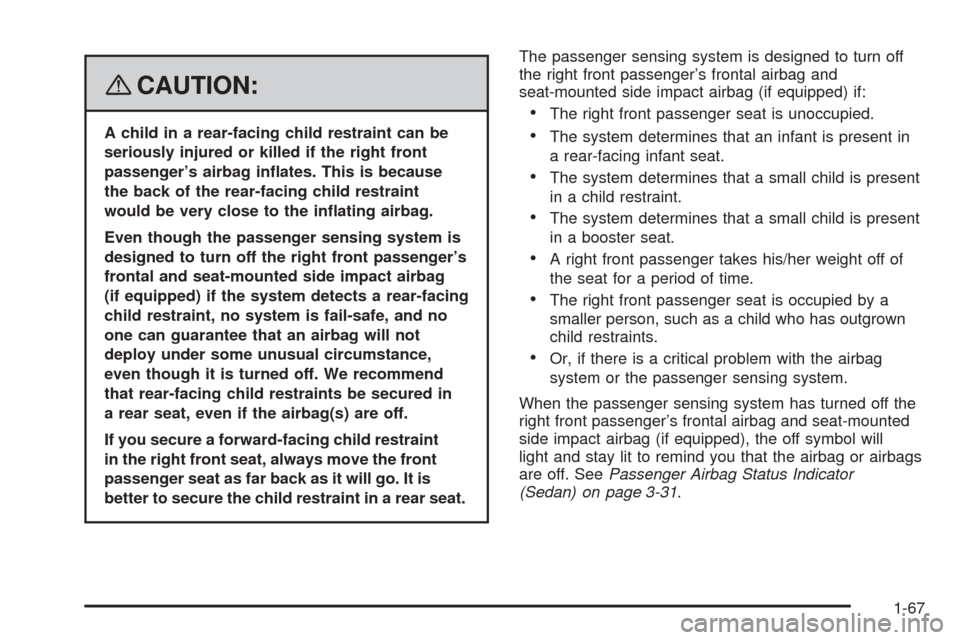
{CAUTION:
A child in a rear-facing child restraint can be
seriously injured or killed if the right front
passenger’s airbag in�ates. This is because
the back of the rear-facing child restraint
would be very close to the in�ating airbag.
Even though the passenger sensing system is
designed to turn off the right front passenger’s
frontal and seat-mounted side impact airbag
(if equipped) if the system detects a rear-facing
child restraint, no system is fail-safe, and no
one can guarantee that an airbag will not
deploy under some unusual circumstance,
even though it is turned off. We recommend
that rear-facing child restraints be secured in
a rear seat, even if the airbag(s) are off.
If you secure a forward-facing child restraint
in the right front seat, always move the front
passenger seat as far back as it will go. It is
better to secure the child restraint in a rear seat.The passenger sensing system is designed to turn off
the right front passenger’s frontal airbag and
seat-mounted side impact airbag (if equipped) if:
•The right front passenger seat is unoccupied.
•The system determines that an infant is present in
a rear-facing infant seat.
•The system determines that a small child is present
in a child restraint.
•The system determines that a small child is present
in a booster seat.
•A right front passenger takes his/her weight off of
the seat for a period of time.
•The right front passenger seat is occupied by a
smaller person, such as a child who has outgrown
child restraints.
•Or, if there is a critical problem with the airbag
system or the passenger sensing system.
When the passenger sensing system has turned off the
right front passenger’s frontal airbag and seat-mounted
side impact airbag (if equipped), the off symbol will
light and stay lit to remind you that the airbag or airbags
are off. SeePassenger Airbag Status Indicator
(Sedan) on page 3-31.
1-67